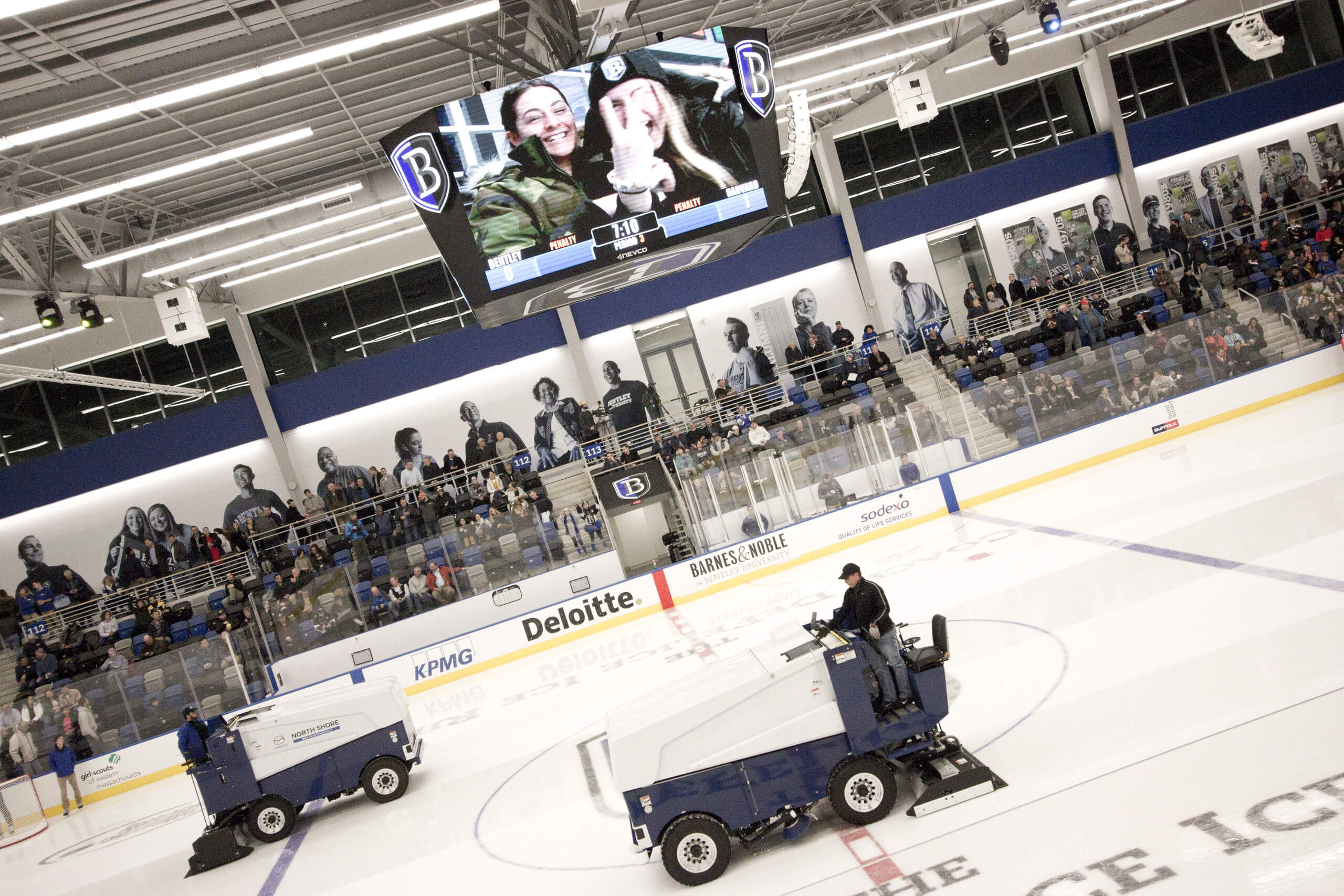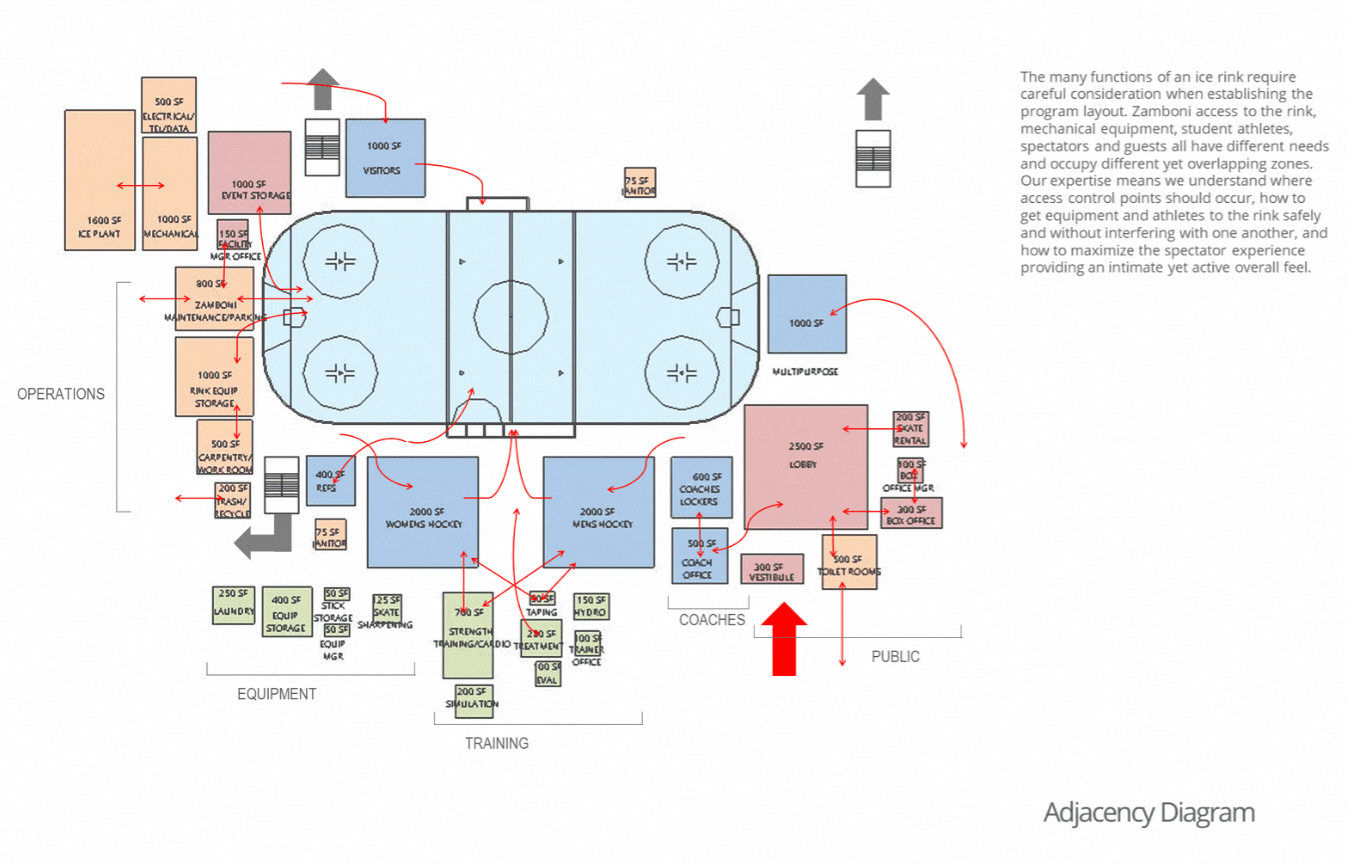Designing for Hockey

Today’s best athletics centers are campus hubs that bring people together and reflect the spirit of community. They reinforce a sense of pride and connection within the larger fabric of a campus. Through the collective thrill and excitement of competition, as well as providing for rest, meditation and wellness, athletics facilities become hallowed ground—places that foster growth, friendship, shared experience, and lasting memories.
With a longstanding commitment to designing spaces that inspire meaningful experiences, where people learn, discover, reflect, and grow, our portfolio of work speaks to our belief that thoughtful, intentional placemaking cultivates connection between people and fills life with moments of inspiration and potential.

Ice Rink/Arena Design Considerations
The successful organization of program components is critical to achieving these outcomes. Primary design considerations for ice rinks and arenas include:
- Site & Environment. Critical to the success of an athletic facility is the integration of the building with the site and environment, with thoughtful consideration given to physical and visual connections to nature, light, and fresh air.
- Roof form gives the building its character but also impacts its uses and required maintenance. Flat roofs are great for photovoltaic arrays, but come with the potential issues of roof drains and maintenance. If site conditions allow, consider a single slope or shed roof optimized for PV. These roofs drain externally, minimizing the risk of overflow or leakage.
- Rink access for the players is critical, but consideration should be given to other users as well. Visiting team spaces need to be functional, but respect the competitive advantage of another’s home turf. If clients partner with the local community to offer ice access, a place to sit and lace your skates and a convenient hook for your coat should be included. Consider whether the venue wants to serve other programs as well – a multipurpose space will get more use than a single-purpose one. Planning ahead for these opportunities means you can avoid compromise to either.
- Locker rooms are important spaces for teaching, building relationships and developing leadership. The layouts need to support team dynamics, with clear sightlines, and provide a place to both celebrate team victories and learn from mistakes. Durable spaces will remain fresh and valued for a long time.
- Space for sports medicine and athletic training is a significant design consideration. Whether it is taping an ankle or providing concussion evaluation, convenient access for the medical staff is a critical component of the planning equation. Easy access to hydration and nutrition are an essential part of an athlete’s conditioning routine.
- The ice resurfacing equipment needs unrestricted access to the ice, adequate room to maneuver, clearance to dispose of the ice scrapings and the ability to be removed from the building for service if needed. These paths of travel should not intersect those of the skater or the public.
- Ensuring the rink feels exciting and full is crucial to providing a lively spectator experience. For smaller venues, one option is to provide limited seating and locate seating aligned with the top of the boards so the fans feel they are physically in the game. In larger venues a sea of seats in multiple colors can feel active even when only partially full. Ideally, the most distant seat should not be farther than 10 rows back from the ice. Warming rooms provide a break from the cooler temps of the rink typically while still allowing views to the action. Consider whether a venue of this type will contribute to the lively atmosphere or potentially draw people away.
- Ice making equipment should be efficient, reliable, and long-lived. The decision to use a commercial or industrial grade system, or a combination of components from each will be a balance of quality and cost.
- Efficient design conditions for a rink space include 50 degrees Fahrenheit and 55% relative humidity. This is achievable most of the winter, but as climates shift and use of the facility in the shoulder season expands, schools should consider a dehumidification system.
- Plant equipment generally comes as either a package/skid mount system or as a series of “stick built” components. Stick built systems take up more room but are easier to access for service, whereas skid mount systems can be modular and more easily replaced.
- Choice of refrigerant can affect mechanical room placement and design.

Sustainability Considerations
For ARC, good design includes environmental stewardship, and a commitment to designing buildings that move beyond checklists. It’s about developing a more resilient design and construction process that actively and consistently supports the health and well-being of our building occupants. Reducing energy consumption, enhancing occupant comfort, eliminating toxins, and providing access to light, fresh air and the landscape are a product of a thoughtful design approach. As we confront the crisis of climate change, our work demands not only better energy performance, but transformative change, requiring fundamental shifts in attitude, thinking and practice towards a more effective and holistic approach to design.
- Alternative Energy Sources - in addition to the traditionally used gas or electric systems, ice plants can be run off geothermal, thermo-storage, hybrid, or even direct solar systems.
- Waste Heat Recovery – the heat generated by the ice plant system can be used to offset other heating demands throughout the building. It is commonly repurposed to heat the snowmelt pit and provide subfloor heating beneath the rink surface, but its use can be taken a step further. Enhanced options include domestic hot water, resurfacer water, dehumidification, arena space heating and even radiant floor heat in locker rooms and public spaces.
- Rooftop Solar Arrays - the roof of a rink may create room for a solar photovoltaic array to offset energy use.
Our design achieves its full potential when each individual use overlays and strengthens its surroundings. ARC’s approach creates a natural choreography among social, athletic, educational, and support spaces. This leads to the development of vibrant atmospheres that energize buildings, and in turn, campuses and their communities.
